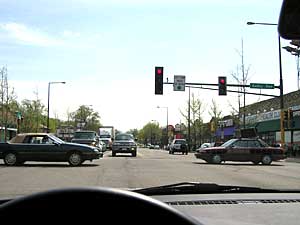|
Audio
Photos
Resources
|
April 23, 2005
 |
| A new report says that traffic signals are not synchronized properly, leading to stop-and-go traffic, wasted gasoline and more air pollution. (MPR Photo/Greta Cunningham) |
St. Paul, Minn. — As you drive around town on your daily commute, you may find yourself stuck in traffic and getting poor gas mileage. One of the big reasons could be the poor design of the traffic light system.
A report card released recently shows traffic signals across the country are largely inefficient and could contribute to road rage and pollution. The National Transportation Operations Coalition conducted the study. It gives the nation's overall traffic signal system a D-minus.
The report says out-of-whack signals cause too much stop-and-go traffic, which frustrates drivers, wastes gas and increases air pollution.
The report says most areas don't have a viable plan for traffic signal operation, don't have the staff to monitor traffic before and after normal work hours, and don't conduct regular reviews.
It may be a matter of money. The report estimates that improving the system could cost about $965 million a year.
Ray Starr, assistant state traffic engineer with the Minnesota Department of Transportation, says he's not surprised by the report. He says Minnesota's system is a bit better than the nation -- it got a C-minus.
Starr agrees the biggest problem with the traffic signal system in the U.S. and Minnesota is signal timing. Starr says when signals are timed properly, it can help speed up traffic and increase safety.
Starr admits to running an occasional red light himself, and says it's not illegal to go through an intersection on a yellow light.
Starr expects Minnesota's traffic signal system will improve as the Department of Transportation puts new technologies in place and refines the timing system.
He recently took a drive with MPR's Greta Cunningham and talked more about the problem with traffic signals. To listen to their interview, choose the audio link in the right column.




